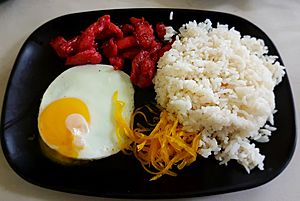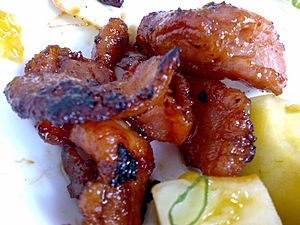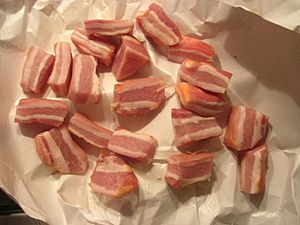Tocino facts for kids
Tocino is a delicious type of cured meat, often made from pork. The word "tocino" actually means "bacon" in Spanish! But depending on where you are in the world, tocino can be very different. In some places, it's like crunchy fried pork fat. In others, especially the Philippines, it's a sweet and savory cured pork dish.
Contents
What is Tocino in Spain?
In Spain, tocino usually refers to the thick layer of fat found just under a pig's skin. It's almost pure fat! This kind of tocino is often salted and cut into small cubes. People in Spain use it in traditional recipes, like a hearty stew called cocido. It adds a lot of flavor to these dishes.
Philippine Tocino: Sweet and Savory

In the Philippines, tocino is quite special. It's made from thin slices of pork belly. To make it, the meat is mixed with ingredients like anise wine, a natural coloring called annatto, water, sugar, and salt. This mixture helps to cure the meat. The pork slices are stacked and kept in the refrigerator for about three days. This curing process gives tocino its unique sweet and savory taste.
Sometimes, people add pineapple juice to the marinade. This gives the tocino a slightly tart or sour flavor, which many people enjoy!
How Philippine Tocino is Cooked
Traditionally, Philippine tocino is cooked in a few ways. You can boil it in a little water until the water evaporates. Then, you fry it in oil until it's nicely browned and cooked through. Another way is to cook it over medium heat until the fat melts and makes the meat tender.
The Kapampangan people in the Philippines have a special way of making tocino. They simmer it for many hours, sometimes four to six, to make it very thick and soft. They might even leave it out overnight to ferment a little, calling it burong baboy (fermented pork).
Tocino for Breakfast: Tosilog
Tocino is a super popular breakfast food in the Philippines. It's often served as part of a meal called tosilog. This fun name is a mix of three words:
- TOCINO
- SINANGÁG (which is delicious garlic fried rice)
- ITLÓG (which means egg, usually fried or scrambled)
So, if you order tosilog, you get a plate with sweet tocino, flavorful garlic rice, and a perfectly cooked egg! It's a favorite way to start the day.
Tocino in the Caribbean
In Caribbean countries like Puerto Rico and Cuba, tocino is different from the sweet Philippine version. Here, it's made from pork fatback. It's not cured or smoked. Instead, it's simply cut into small squares and fried until it's super crunchy. This crispy tocino is then added to many dishes, much like how lardons are used in French cooking. You might find it in mofongo or arroz blanco con tocino (white rice with tocino). In Cuba, it can even be added to soft bread!
Tocino in Central America
In Nicaragua, tocino is prepared in a special way for a traditional dish called the Nacatamal. The tocino is marinated with a red spice called achiote, bitter orange juice, and vinegar. Then, it's placed inside the Nacatamal, which is a type of tamale, and cooked by steam.
Tocino in the United States
Even in the United States, you can find tocino-flavored products! The Hormel Foods Corporation makes a special tocino-flavored version of their famous SPAM product. You can often find this unique flavor in supermarkets.
See also
 In Spanish: Tocino (Filipinas) para niños
In Spanish: Tocino (Filipinas) para niños



